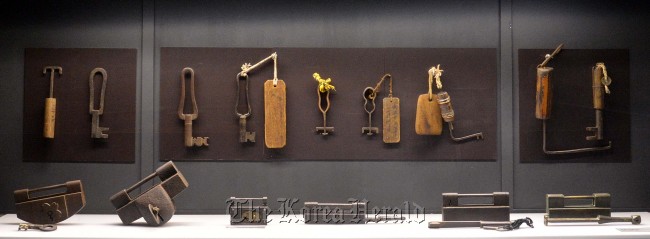Unlocking pieces of Korean history
Museum offers a glimpse of the past through locks and latches
By Korea HeraldPublished : Nov. 13, 2012 - 19:32
Society today is riddled with the latest and best security systems for protecting valuables. Everything of value seems to hide behind the protective barriers of deadbolts, eye scanners, key pads or voice and fingerprint recognition, elements that made films like “Ocean’s 11” so intriguing. Technological advancements have allowed for an increase in the beefiness of high-tech security to the point where old-fashioned keys and locks are slowly becoming things of the past — soon to be archaic relics replaced in the era of electronic protection.
However, one man sees these locks and keys as more than just a means of safeguarding, but as a lens looking into the history of craftsmanship and life in the past.
Nestled away in the budding theatre district of Daehangno is the nation’s only lock museum, run by Choi Hong-kyu. The Lock Museum, which opened its doors in 2003, houses an array of antique locks, latches and key charms dating back to the Goryeo and Joseon periods.
However, one man sees these locks and keys as more than just a means of safeguarding, but as a lens looking into the history of craftsmanship and life in the past.
Nestled away in the budding theatre district of Daehangno is the nation’s only lock museum, run by Choi Hong-kyu. The Lock Museum, which opened its doors in 2003, houses an array of antique locks, latches and key charms dating back to the Goryeo and Joseon periods.

Choi worked at a hardware shop for most his life and even ran his own store.
His work with metal sparked an interest in craftsmanship and locksmiths leading him to collecting various antique locks. “I thought to myself, ‘What is it that I know best?’ and the answer was locks,” he said.
Thirty years later, he has amassed an impressive collection of approximately 5,000 locks, latches and key charms.
“For the last four years I’ve tried to feel the pulse of our culture under the name of “soetdae” (steel keys) through locks, latches and key charms,” said the collector. “They are unsophisticated but not trivial, simple but beautiful.”
Each lock tells a story rich in history and culture: In the days of yore, locks even had distinctive styles based on the province they came from.
Lock designs
“Digeut” locks (named after the Korean character ㄷ), where a flank piece would slide into the backbone of piece, were very common in the Jeolla provinces. Navel or belly button-shaped locks — where keyholes were placed in a rounded piece in the center — were generally seen in the Gyeongsang provinces. Experts can get an idea of where someone came from based on the type of lock they used.
Many locks were also designed using animal shapes and patterns that incorporated superstitious beliefs of prosperity and well-being.
Turtle-shaped locks and latches were particularly popular because turtles, due to their long life spans, were widely perceived as a symbol of immortality. The thick shell on the lock was seen as a protective concept, so it was mainly used to safeguard valuables.
Fish-shaped locks were also common because fish are known to sleep with their eyes open and are therefore thought to be good guards and defenders of fortune.
“Just by looking at the properties of these locks you can get a glimpse of what life was like during that time,” Choi said. “Through these locks, you can grasp a mutual understanding of the past.”
Secret locks
Traditional Korean locks not only incorporated artistic, aesthetic elements, but they were also very scientific in their designs. A “secret lock” entails a labyrinth of puzzle-like components in order for the lock to open.
“These craftsmen didn’t just make these locks; they did it with a certain intelligent design,” Choi said. “One mistake and you have to start all over.”
A secret lock is complex because its keyhole is concealed within the overall structure of the piece and there is a specific sequential set of steps that one must follow in order to gain access.
“It’s like the Da Vinci Code,” he said. These locks are so intricate in their architecture that even Choi sometimes has trouble remembering all the steps to opening one. Some secret locks require as much as seven to eight steps before being they can be unlocked.
The collection
The museum currently showcases around 350 locks, only a small fraction of Choi’s total collection to date.
Among some of his prized possessions is a bronze dual-dragon-head lock from the Goryeo Kingdom, the oldest lock in the museum. “Dragon locks were typically used by the royals, something that commoners weren’t able to use, so it’s of tremendous value,” he said.
At first, Choi only collected Korean locks, but has recently started collecting them from around the world. The museum collection includes several locks from Tibet, Nepal, Afghanistan, India, Japan and China.
The collector even has a pair of European male and female chastity belts on display.
“These are my children,” he said while looking at an array of his locks. “I can’t pick just one favorite because I feel the same way about each and every one of them.”
The Lock Museum is located in the Daehango theatre district and is open from 10 a.m. to 6 p.m., Tuesday through Sunday. Admission is 3,000 won for adults, 2,000 won for youths and 1,000 for children. For more information visit www.lockmuseum.org.
By Julie Jackson (juliejackson@heraldcorp.com)
-
Articles by Korea Herald





![[KH Explains] No more 'Michael' at Kakao Games](http://res.heraldm.com/phpwas/restmb_idxmake.php?idx=644&simg=/content/image/2024/04/28/20240428050183_0.jpg&u=20240428180321)




![[Grace Kao] Hybe vs. Ador: Inspiration, imitation and plagiarism](http://res.heraldm.com/phpwas/restmb_idxmake.php?idx=644&simg=/content/image/2024/04/28/20240428050220_0.jpg&u=)









